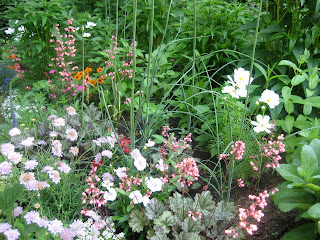There was a great seating arrangement around the fireplace, but the space behind the sofa was dead. The rug was only on temporary loan from our son, who had bought it for his dorm room. And we kind of had to let him have it back. (He has great taste in rugs, though, doesn't he?)
So, I moved the desk back into the dining room, placed the sofa between the windows again and thought about it some more. I concluded that the best recourse was to slipcover the sofa and make a couple of other small changes.
But how to do this on the smallest possible budget? Even 20 yards of inexpensive fabric can add up. And what color/type of fabric?
Here is the list of changes I made to "finish" the living room:
1. Slipcover sofa
2. Purchase a decorative element to go on the wall over the sofa
3. Purchase a floor lamp to complement existing floor lamp on one side of the sofa, for reading
4. Paint the room a "better" shade of white
And here are the changes I made.
1. Use Ikea curtains for the slipcover fabric!
I decided to use blue and green as the main color theme for the first floor of our house. The living room wanted more blue in it, so blue it was. My choice was Ikea's Lenda curtains in light blue. It is a tough, fairly tightly woven chambray.
It has a subtle stripe woven in every six inches, which made cutting out the fabric and lining up seams a bit easier. I think I ended up purchasing 5 pairs of curtains at $25 per pair. And I have a bit less than two curtains' worth left, should I need to sew a replacement cushion cover or two. I started this in February, and stumbled along until I finished in May.
Next, I splurged on a decorative trim for the bottom hem. It is the popular Greek Key design, in pale blue and antique, from M&J Trimming.
Good so far. Finally, as the "pillow queen," as my husband calls me, I had to recover the current pair of throw pillows. I wanted something more current and saturated in color to punch up the dusky blue of the sofa. Calico Corner's Tala in Bluemarine from their Annie Selke collection fit the bill perfectly.
2. Use a round mirror
We've been in this house for seven years, and I still couldn't decide what I wanted to hang on the space above the sofa. It is typical to hang a piece of art designed to blend in with the color scheme; it is also dreadfully boring and predictable. Among other ideas, I considered framing a piece of wallpaper, hanging an old textile, doing a gallery-style collection of assorted smaller pieces, painting a mural, or just doing nothing. In the meantime, we tried two or three pieces we already owned. They all made me yawn. Then it struck me that we needed something round. There are already so many squares and rectangles in the room. A round object, specifically a mirror, would liven up the somewhat plain jane furnishings. This one from Ballard Designs not only meets my requirements, it was affordable:
3. Find an affordable floor lamp that complements the other four in the room, none of which match.
This was easy. I found it on the Circa Lighting website, on sale. Nuff said.
4. Find the right white
Sigh. This was the most difficult part. I ended up taking home large samples from my firm's Benjamin Moore professional catalogue of BM colors. I considered Acadia White, Navajo White, Lancaster Whitewash, and White Dove. I chose Lancaster Whitewash, which wasn't too pink or yellow, but more of a very pale warm cement. Warm cement doesn't sound very nice. But really, it makes a great wall color.
Next post: the results!

































